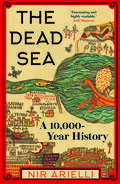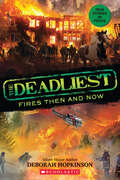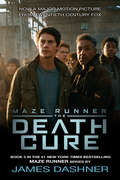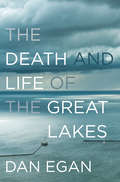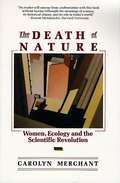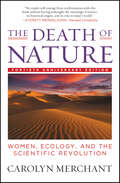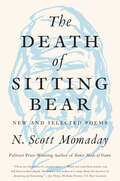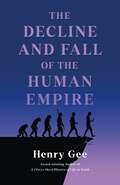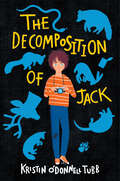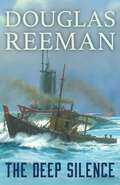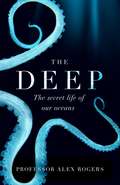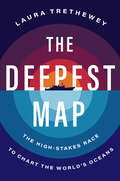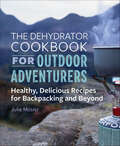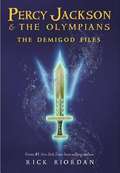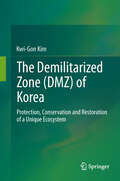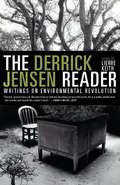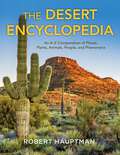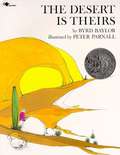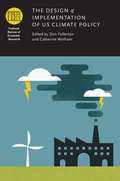- Table View
- List View
The Dead Sea: A 10,000 Year History
by Nir ArielliA human history of one of the planet&’s most iconic lakes, and the civilizations that surrounded its shores The Dead Sea is a place of many contradictions. Hot springs around the lake are famed for their healing properties, though its own waters are deadly to most lifeforms—even so, civilizations have built ancient cities and hilltop fortresses around its shores for centuries. The protagonists in its story are not only Jews and Arabs, but also Greeks, Nabataeans, Romans, Crusaders and Mamluks. Today it has become a tourist hotspot, but its drying basin is increasingly under threat. In this panoramic account, Nir Arielli explores the history of the Dead Sea from the first Neolithic settlements to the present day. Moving through the ages, Arielli reveals the religious, economic, military, and scientific importance of the lake, which has been both a source of great wealth and a site of war. The Dead Sea weaves together a tapestry of the lake&’s human stories—and amidst environmental degradation and renewed conflict, makes a powerful case for why it should be saved.
The Deadliest Fires Then and Now (The Deadliest)
by Deborah HopkinsonPerfect for fans of I Survived and the Who Was series, and packed with graphics, photos, and facts for curious minds, this is a gripping look at the deadliest fires in American history.As the sun sank over the town of Peshtigo, Wisconsin, one warm October night in 1871, a smoky haze hung in the dry air. There had been little rain, and small fires had been rolling through town continuously since the Summer. For weeks the people had tried to protect their homes and businesses from fire. But they could not protect themselves from what would culminate in the deadliest fire in American history.As industrialization surged across the country, and Westward colonization leveled forests to build cities, fires became a mainstay in American life. And as populations grew, so too did the human toll that fire could exact. Through the nineteenth and twentieth centuries, Americans searched for new and innovative ways to combat the threat of fire. And with climate change threatening to set the whole world aflame, we are once again in a fight for our planet’s future.Through the eyes of scientists, witnesses, and survivors of terrible fires alike, Sibert Honor author Deborah Hopkinson brings the horrific history of deadly fires to life, tracing a line from the Peshtigo and Great Chicago fires of 1871 to the wildfires raging in the western United States today. Filled with more than 50 period photographs and illustrations, facts, and pull-out boxes for eager nonfiction readers.
The Death Cure: The Death Cure - The Official Graphic Novel Prelude (The Maze Runner #3)
by James DashnerThomas knows that Wicked can't be trusted, but they say the time for lies is over, that they've collected all they can from the Trials and now must rely on the Gladers, with full memories restored, to help them with their ultimate mission. It's up to the Gladers to complete the blueprint for the cure to the Flare with a final voluntary test. What Wicked doesn't know is that something's happened that no Trial or Variable could have foreseen. Thomas has remembered far more than they think. And he knows that he can't believe a word of what Wicked says. The time for lies is over. But the truth is more dangerous than Thomas could ever imagine. Will anyone survive the Death Cure? <P><P> <i>Advisory: Bookshare has learned that this book offers only partial accessibility. We have kept it in the collection because it is useful for some of our members. Benetech is actively working on projects to improve accessibility issues such as these.</i>
The Death and Life of the Great Lakes
by Dan Egan<P>A landmark work of science, history and reporting on the past, present and imperiled future of the Great Lakes. <P>The Great Lakes—Erie, Huron, Michigan, Ontario and Superior—hold 20 percent of the world’s supply of surface fresh water and provide sustenance, work and recreation for tens of millions of Americans. But they are under threat as never before, and their problems are spreading across the continent. <P>The Death and Life of the Great Lakes is prize-winning reporter Dan Egan’s compulsively readable portrait of an ecological catastrophe happening right before our eyes, blending the epic story of the lakes with an examination of the perils they face and the ways we can restore and preserve them for generations to come. <P>For thousands of years the pristine Great Lakes were separated from the Atlantic Ocean by the roaring Niagara Falls and from the Mississippi River basin by a “sub-continental divide.” Beginning in the late 1800s, these barriers were circumvented to attract oceangoing freighters from the Atlantic and to allow Chicago’s sewage to float out to the Mississippi. These were engineering marvels in their time—and the changes in Chicago arrested a deadly cycle of waterborne illnesses—but they have had horrendous unforeseen consequences. <P> Egan provides a chilling account of how sea lamprey, zebra and quagga mussels and other invaders have made their way into the lakes, decimating native species and largely destroying the age-old ecosystem. And because the lakes are no longer isolated, the invaders now threaten water intake pipes, hydroelectric dams and other infrastructure across the country. <P>Egan also explores why outbreaks of toxic algae stemming from the overapplication of farm fertilizer have left massive biological “dead zones” that threaten the supply of fresh water. He examines fluctuations in the levels of the lakes caused by manmade climate change and overzealous dredging of shipping channels. And he reports on the chronic threats to siphon off Great Lakes water to slake drier regions of America or to be sold abroad. <P>In an age when dire problems like the Flint water crisis or the California drought bring ever more attention to the indispensability of safe, clean, easily available water, The Death and the Life of the Great Lakes is a powerful paean to what is arguably our most precious resource, an urgent examination of what threatens it and a convincing call to arms about the relatively simple things we need to do to protect it.
The Death of Nature: Women, Ecology and the Scientific Revolution
by Carolyn MerchantHow the scientific revolution sanctioned the exploitation of nature, commercial expansion, and the subjugation of women.
The Death of Nature: Women, Ecology, and the Scientific Revolution
by Carolyn MerchantUPDATED 40TH ANNIVERSARY EDITION WITH 2020 PREFACEAn examination of the Scientific Revolution that shows how the mechanistic world view of modern science has sanctioned the exploitation of nature, unrestrained commercial expansion, and a new socioeconomic order that subordinates women.
The Death of Sitting Bear: New and Selected Poems
by N. Scott MomadayPulitzer Prize winner and celebrated American master N. Scott Momaday returns with a radiant collection of more than 200 new and selected poems rooted in Native American tradition. “The poems in this book reflect my deep respect for and appreciation of words. . . . I believe that poetry is the highest form of verbal expression. Although I have written in other forms, I find that poems are what I want and need most to read and write. They give life to my mind.”One of the most important and unique voices in American letters, distinguished poet, novelist, artist, teacher, and storyteller N. Scott Momaday was born into the Kiowa tribe and grew up on Indian reservations in the Southwest. The customs and traditions that influenced his upbringing—most notably the Native American oral tradition—are the centerpiece of his work.This luminous collection demonstrates Momaday’s mastery and love of language and the matters closest to his heart. To Momaday, words are sacred; language is power. Spanning nearly fifty years, the poems gathered here illuminate the human condition, Momaday’s connection to his Kiowa roots, and his spiritual relationship to the American landscape. The title poem, “The Death of Sitting Bear” is a celebration of heritage and a memorial to the great Kiowa warrior and chief. “I feel his presence close by in my blood and imagination,” Momaday writes, “and I sing him an honor song.” Here, too, are meditations on mortality, love, and loss, as well as reflections on the incomparable and holy landscape of the Southwest.The Death of Sitting Bear evokes the essence of human experience and speaks to us all.
The Decline and Fall of the Human Empire: Why Our Species Is on the Edge of Extinction
by Henry GeeBy the award-winning author of A (Very) Short History of Life on Earth: a history of humanity on the brink of decline.A Next Big Idea Club Must-Read SelectionWe are living through a period that is unique in human history. For the first time in more than ten thousand years, the rate of human population growth is slowing down. In the middle of this century population growth will stop, and the number of people on Earth will start to decline - fast. In this provocative book, award-winning science writer Henry Gee offers a concise, brilliantly-told history of our species--and argues that we are on a rapid, one-way trip to extinction. The Decline and Fall of the Human Empire narrates the dramatic rise of humanity, how a scattered range of small groups across several continents eventually inbred, interacted, fought, established stable communities and food supplies, and began the process of dominating the planet. The human story is relatively brief—the oldest fossils of H. Sapiens date to approximately 300,000 years ago—yet the spread of our species has been unstoppable…until recently. As Gee demonstrates, our population has peaked, and is declining; our environment is becoming inimical to human life in many locations; our core resources of water, arable land, and air are diminishing; and new diseases, simmering conflicts, and ambiguous technologies threaten our collective health. Can we still change our course? Or is our own extinction inevitable?There could be a way out, but the launch window is narrow.Unless Homo sapiens establishes successful colonies in space within the next two centuries, our species is likely to stay earthbound and will have vanished entirely within another ten thousand years, bringing the seven-million-year story of the human lineage to an end.With assured narration, dramatic stories, and his signature sprightly humor, Henry Gee envisions new opportunities for the future of humanity—a future that will reward facing challenges with ingenuity, foresight, and cooperation.
The Decomposition of Jack
by Kristin O'Donnell TubbAward-winning author Kristin O’Donnell Tubb delivers a funny and poignant middle grade contemporary novel about family and friendship as Jack deals with his parents’ divorce while also searching for a mysterious cougar in the Tennessee hills. Perfect for fans of Leslie Connor and Lynda Mullaly Hunt. A Junior Library Guild Selection!Middle school is always hard, but when you’re known as the Roadkill Kid, well, it’s even harder. Jack’s mom collects roadkill—it’s her job, and she’s very good at it. Ever since Jack’s mom and dad got divorced, Jack has stepped into the role of Mom’s co-scientist.One day while tending to the roadkill garden, Jack believes he spots a cougar in the wilderness beyond his backyard. A cougar in Tennessee? They’re supposed to be extinct. So, when Jack has to choose an animal to research for his Earth Science class, he picks cougar.As pressure mounts on Jack to complete his project and to be Mom’s business partner, the mystery of the cougar feels too big to solve. Jack knows what the decomposition of an animal—and a family—looks like, so can he figure out how to bring them back to life?
The Deep Silence
by Douglas ReemanMarch 1967: HMS Temeraire is Britain&’s latest and most advanced nuclear submarine. But when the Temeraire&’s trials are cut short and she is ordered to the Far East to reinforce the British fleet against a threat from Red China, Captain David Jermain knows that this is no routine exercise in flag-waving. And once in Asian waters, he and his submarine find themselves involved in a hidden, undeclared conflict beneath the sea. While the politicians on land haggle over a situation that could hold the seeds of a full-scale war, Commander Jermain must keep his faith in himself and in his new ship&’s potential—even when ordered to take the Temeraire to the edge of a catastrophe.
The Deep: The Hidden Wonders of Our Oceans and How We Can Protect Them
by Alex RogersThere's so much we don't know about what lies deep beneath the ocean's surface - and the time to find out is growing increasingly precious . . .Professor Alex Rogers is one of the world's leading experts in marine biology and oceanology, and has spent his life studying the deep ocean - and in particular the impact of human activity on the ecosystems of the oceans. In this timely, galvanising and fascinating book - replete with stunning photography of strange and beautiful creatures - Professor Rogers offers a fundamentally optimistic view of humanity's relationship with the oceans - and also a very personal account of his own interaction with the seas.
The Deep: The Hidden Wonders of Our Oceans and How We Can Protect Them
by Alex Rogers'[An] authoritative, hands-on study' NatureFrom one of the world's pre-eminent marine biologists comes a dazzling account of the wonders that lie beneath the ocean's surface, and an empowering vision of how we can protect themFewer people have been to the deepest part of the ocean than have been to the moon. Even now, the vast majority of this wilderness - which covers over 70% of the planet and forms its largest ecosystem - has never been seen by human eyes, let alone explored or investigated by scientists. Yet our oceans contain perhaps 90% of all life, and the physical and biological processes within it are critical to supporting our existence on Earth.Professor Alex Rogers has spent the past 30 years studying life in the deep ocean. In this book, he takes us on an epic and utterly unforgettable voyage to an alien world, and brings us right to the edge of what is known about our oceans today. Introducing us to glittering coral gardens, submarine mountains and a range of bizarre and breathtaking sea creatures, many of which he discovered first-hand, Rogers not only illustrates the ocean's enormous and untold impact on our lives, but also shows how we are damaging it catastrophically through pollution, overfishing, and the insidious and global effects of climate change.Imbued with the author's infectious sense of wonder, and replete with stunning photography of underwater life, The Deep is a magisterial study of a world we are only just beginning to understand - and a profoundly hopeful call to arms for us to reshape our relationship with it, before it is too late.
The Deep: The Hidden Wonders of Our Oceans and How We Can Protect Them
by Alex RogersThere's so much we don't know about what lies deep beneath the ocean's surface - and the time to find out is growing increasingly precious . . .Professor Alex Rogers is one of the world's leading experts in marine biology and oceanology, and has spent his life studying the deep ocean - and in particular the impact of human activity on the ecosystems of the oceans. In this timely, galvanising and fascinating book - replete with stunning photography of strange and beautiful creatures - Professor Rogers offers a fundamentally optimistic view of humanity's relationship with the oceans - and also a very personal account of his own interaction with the seas.(P)2019 Headline Publishing Group Ltd
The Deepest Map: The High-Stakes Race to Chart the World's Oceans
by Laura TretheweyThe dramatic and action-packed story of the last mysterious place on earth—the world’s seafloor—and the deep-sea divers, ocean mappers, marine biologists, entrepreneurs, and adventurers involved in the historic push to chart it, as well as the opportunities, challenges, and perils this exploration holds now and for the future.Five oceans—the Atlantic, the Pacific, the Indian, the Arctic, and the Southern—cover approximately 70 percent of the earth. Yet we know little about what lies beneath them. By the early 2020s, less than twenty-five percent of the ocean’s floor has been charted, most close to shorelines, and over three quarters of the ocean lies in in what is called the Deep Sea, depths below a thousand meters. Now, the race is on to completely map the ocean’s floor by 2030—an epic project involving scientists, investors, militaries, and private explorers who are cooperating and competing to get an accurate reading of this vast terrain and understand its contours and environment. In The Deepest Map, Laura Trethewey documents this race to the bottom, following global efforts around the world, from crowdsourcing to advances in technology, recent scientific discoveries to tales of dangerous dives in untested and costly submersibles. The lure of ocean exploration has attracted many, including the likes of James Cameron, Richard Branson, Ray Dalio, and Eric Schmidt. The Deepest Map follows a cast of intriguing characters, from early mappers such as Marie Tharp, a woman working in the male-dominated fields of oceanography and geology whose discoveries have added significantly to our knowledge; Victor Vescovo, a man obsessed with reaching the deepest depths of each of the five oceans, and his young, brilliant, and fearless mapper Cassie Bongiovanni; and the diverse entrepreneurs looking to explore and exploit this uncharted territory and its resources.In The Deepest Map, ocean discovery converges with humanity's origin story; in mapping the ocean floor, scientists are actively tracing our roots back to the most inhospitable places on earth where life began—and flourished. But for every conservationist looking to protect the seafloor, there are others who see its commercial potential. Will a new map exacerbate pollution and the degradation of this natural resource? How will the race remake political power structures in years to come? Trethewey probes these questions as countries and conglomerates wrestle over the riches that may lie at the bottom of the sea.The future of humanity depends on our ability to protect this vast, precious, and often ignored resource. A true tale of science, nature, technology, and an extreme outdoor adventure The Deepest Map illuminates why we love—and fear—the earth’s final frontier and is a crucial addition to the increasingly urgent conversation about climate change.
The Deeside Way: Long Distance Guide (Long Distance Guides)
by Peter Evans&“The first guide to one of Scotland&’s long-distance trails&” from an experienced hillwalker and former editor of The Great Outdoors magazine (The Northern Times). The Deeside Way is a long-distance path running for 66km (41 miles) from Aberdeen, the oil capital of Europe, to Ballater in Royal Deeside in the Cairngorms National Park. Mainly following the course of old Royal Deeside Railway line, it is suitable for cyclists as well as walkers. There is much to be seen along the Way of scenic beauty, historical interest, and thriving wildlife. There are fascinating links to the Romans, to Queen Victoria and Balmoral, and even to bodysnatchers! This new Guide covers all of these, with a wealth of practical information on preparation for the walk, accommodation, transport, and much else. As well as describing the Way itself, Peter Evans includes six additional walks in and around Deeside, varying from short low-level walks to mountain summits.
The Dehydrator Cookbook for Outdoor Adventurers: Healthy, Delicious Recipes for Backpacking and Beyond
by Julie MosierHearty meals for the trail—from your dehydrator to your destination.Want to dig into a warm, delicious meal in the wilderness without filling your pack with heavy ingredients? It's easy with The Dehydrator Cookbook for Outdoor Adventurers. Just prep your favorite recipes from the book to dehydrate at home—to savor when you're far from home.This dehydrator cookbook includes easy instructions for cooking, dehydrating, storing, and reconstituting all kinds of foods. Try recipes for Lemony Lentil Salad, Salmon and Roasted Sweet Potato Hash, Porter-Infused Chili with Bacon, and more. Choose the perfect lightweight dishes to keep your body fueled while you trek, and learn how to pack provisions efficiently.The Dehydrator Cookbook for Outdoor Adventurers includes:For every meal—Enjoy a variety of flavorful recipes for breakfast, lunch, and dinner (and don't forget dessert!) from this dehydrator cookbook.Nutritious staples—Create your own combos with instructions for easily dehydrating individual foods like fruits, veggies, and grains.Planning and prep—You'll be prepared with plenty of meal planning tips for your adventures, including a sample menu for reference.With The Dehydrator Cookbook for Outdoor Adventurers, you'll be able to enjoy the fresh air—while enjoying tasty, nourishing meals.
The Delaware Naturalist Handbook (Cultural Studies of Delaware and the Eastern Shore)
by McKay Jenkins and Susan BartonThe Delaware Naturalist Handbook is the primary public face of a major university-led public educational outreach and community engagement initiative. This statewide master naturalist certification program is designed to train hundreds of citizen scientists, K–12 environmental educators, ecological restoration volunteers, and habitat managers each year. The initiative is conducted in collaboration with multiple disciplines at the University of Delaware, the University of Delaware Cooperative Extension, the Delaware Environmental Institute (DENIN), the state Department of Natural Resources and Environmental Conservation (DNREC), the state Division of Parks, the state Forest Service, the state Division of Fish and Wildlife, and local nonprofit educational institutions, including the Mount Cuba Center, the Delaware Nature Society and Ashland Nature Center, Delaware Wildlands, Northeast Climate Hub, Center for Inland Bays, and White Clay Creek State Park.
The Demigod Files (Percy Jackson and the Olympians)
by Rick RiordanBecome an expert on everything in Percy's world with this must-have guide to the Percy Jackson and the Olympians series. Complete with interviews, puzzles, games, and original short stories by Rick Riordan.
The Demilitarized Zone (DMZ) of Korea: Protection, Conservation and Restoration of a Unique Ecosystem
by Kwi-Gon KimUntouched since 1953, the Korean DMZ (Demilitarized Zone) has transformed itself into one of the few ecologically pristine zones and a vital habitat for endangered species. Often cited as a potential "peace park", it could one day be a common ground for reconciliation and harmony. A wealth of data and information has been produced over time, documenting significant aspects of the DMZ and its implications for human and ecological security, both in Korea and worldwide. However, there is no single book in English that brings together the findings on the mechanism of evolution, the ecology and biodiversity of the DMZ. "The DMZ of Korea", by Kwi-Gon Kim, is the first step in this direction. It seeks to link scientific information and policy making for the future DMZ ecosystem management, taking into account the fact that the area has become, over the years, a natural treasure as a habitat for rare birds and other wildlife and a fertile environment for a thriving plant community. It also provides a framework for ensuring the long-term sustainability of the DMZ. The book holistically describes the current environmental status of the DMZ, and identifies bioregions, resources, habitats, and species. By outlining the current scientific data and information needed to classify the different wetland types, assess the biological integrity, understand the threat factors, and to suggest conservation and management strategies, the book provides a "one stop shop" scientific and policy source of information, which will undoubtedly be of great interest to students, researchers, practitioners, and policy decision-makers, in the areas of planning, natural resource management, public management, ecology, landscape architecture, geography, and the life sciences. Prof.Dr.Kwi-Gon Kim obtained his Ph.D. at UCL, University of London, UK. He is a professor emeritus at Seoul National University and the Co- President of the Korea DMZ Council in Seoul, Korea.
The Derrick Jensen Reader: Writings on Environmental Revolution
by Derrick Jensen Lierre KeithIn an age marked by seemingly unstoppable environmental collapse and the urgent quest for solutions, environmental philosopher Derrick Jensen, the voice of the growing deep ecology movement, reveals for us new seeds of hope. Here for the first time in The Derrick Jensen Reader are collected generous selections from his prescient, unflinching books on the problem of civilization and the path to true resistance.In the acclaimed A Language Older Than Words, Jensen dissects his own abusive childhood to examine the pathology of Western culture and shares with us the power and beauty of an alliance with the natural world. He continues to use the lens of his own experience as well as the wisdom of philosophers, activists, and teachers to expose oppression and call us to action in his other early works, Listening to the Land, A Culture of Make Believe, Strangely Like War, and Walking on Water. We see his analysis deepen when he asks us to accept that the only moral response to biocide is resistance in the two-volume Endgame, a truth he explores further in Thought to Exist in the Wild, What We Leave Behind, the graphic novel As The World Burns, and in his two novels, Songs of the Dead and Lives Less Valuable. And in Dreams, Jensen's latest work, he leads us still further toward his vision for a healed planet, freeing us to see beyond the limits of our present culture to a future luminous with meaning.
The Desert Alphabet Book (Jerry Pallotta's Alphabet Books)
by Jerry PallottaThe parched, mysterious deserts of the world are the landscapes for this alphabet array of plants, animals, and phenomena. Meet the colorful Crimson Chat, the deadly Inland Taipan, and the cartwheeling Golden Wheel Spider. Look beneath and beyond the sand for familiar, unfamiliar, and comical desert dwellers.Author Jerry Pallotta and illustrator Mark Astrella invite readers to one of nature's most forbidding environments. And if you feel thirsty after reading about some of the driest places on earth, don't worry. There's a Water-holding frog!
The Desert Encyclopedia: An A–Z Compendium of Places, Plants, Animals, People, and Phenomena
by Robert HauptmanThis reference work is the first English-language A-Z compendium on all topics related to deserts, including geography, geology, meteorology, climatology, hydrology, botany, zoology, anthropology, art, music, film, culture, sports, as well as the specific and diversely different deserts that one finds in all parts of the world. Definitions, explanations, and clarifications will be contained in more than 2,300 entries that vary in length from a brief sentence to detailed overviews of more complex subjects. The Desert Encyclopedia will be invaluable as a source of data and information, but it is also enjoyable to read straight through. It is also replete with line drawings, black-and-white illustrations, maps, and images from outstanding photographers.
The Desert Is Theirs
by Byrd BaylorSimple text and illustrations describe the characteristics of the desert and its plant, animal and human life.
The Design and Implementation of US Climate Policy
by Don Fullerton Catherine WolframEconomic research on climate change has been crucial in advancing our understanding of the consequences associated with global warming as well as the costs and benefits of the various policies that might reduce emissions of greenhouse gases. As nations work to develop climate policies, economic insights into their design and implementation are ever more important. With a balance between theoretical and empirical approaches, The Design and Implementation of US Climate Policy looks at the possible effects of various climate policies on a range of economic outcomes. The studies that comprise the volume examine topics that include the coordination--or lack thereof--between the federal and state governments, implications of monitoring and enforcing climate policy, and the specific consequences of various climate policies for the agricultural, automotive, and buildings sectors.
The Destruction of Palestine Is the Destruction of the Earth
by Andreas MalmMalm unearths the shared roots of colonial adventurism in Palestine and fossil fuelled warfare.Israel&’s pulverization of Gaza since October 7, 2023 is not only a humanitarian crisis, but an environmental catastrophe. Far from the first event of its kind, the devastation Israel has inflicted on Palestine since October 2023 has merely ushered in a new phase in a long history of colonization and extraction that reaches back to the nineteenth century. In this urgent pamphlet, Andreas Malm argues that a true understanding of the present crisis requires a longue durée analysis of Palestine's subjugation to fossil empire. Returning to the British empire&’s first use of steam-power in war, in which it destroyed the Palestinian city of Akka, Malm traces the development of Britain&’s fossil empire and shows how this enduring commitment to fossil energy continues to drive Western support for the destruction of Palestine today.
